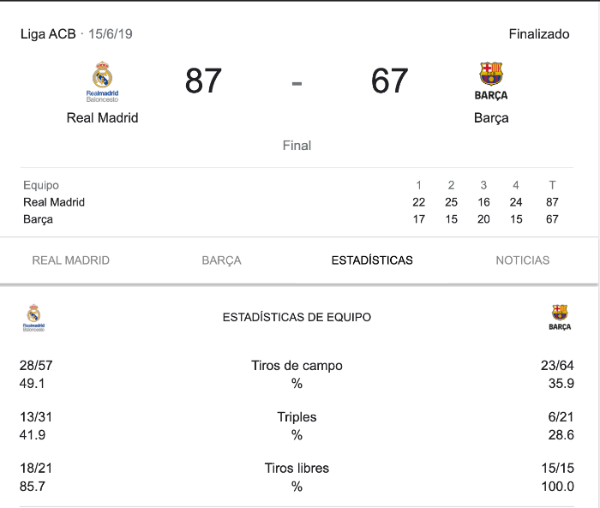
Session 5

Activity 1: Basketball game! (You may answer in spanish)
It's the finals! Real Madrid - FCBarcelona. [br][br]After a close game, the final statistics appear in the following image. [br][br]As basketball experts, you and your group are discussing the ending statistics. Solve the following questions:[br][br]a) What do each of the statistics mean?[br][br]b) Which team [b]hit more field shots[/b]? And [b]triples[/b]? And [b]free shots[/b]? [br][br]d) Which team had better [b]aim [/b]in each case?[br][br]c) What kind of shots are harder to hit (field shots, triples, free shots)? Can you see that in the statistics?[br][br]d) The commentator says: "[i]The second quarter was really good for Real Madrid, they scored more than [math]\text{\frac{1}{4}}[/math][/i] [i]of the total points!" [/i]Is that correct? Why?[br][br]e) Another commentator says: [i]"Barcelona hit more than one out of three triples (uno de cada tres)!" [/i]What does he mean? Is that correct? Why?[br][br]f) Make a small summary of the game.
Activity 2: Comparing fractions
[b]When we compare fractions, we need to use the same unit of reference![br][/b][br]Represent and compare the following fractions. [br][br][i]Try thinking about the result in advance! Can you find the solution using the numbers only?[/i][br][br]1) [math]\text{\frac{1}{5}}[/math] and [math]\text{\frac{1}{6}}[/math] 2) [math]\text{\frac{3}{5}}[/math] and [math]\text{\frac{4}{6}}[/math] 3) [math]\text{\frac{3}{6}}[/math] and [math]\text{\frac{1}{2}}[/math][br][br]4) [math]\text{\frac{5}{6}}[/math] and [math]\text{\frac{3}{4}}[/math] 5) [math]\text{\frac{2}{8}}[/math] and [math]\text{\frac{2}{9}}[/math] 6) [math]\text{\frac{7}{8}}[/math] and [math]\text{\frac{8}{9}}[/math]
Comparing fractions in general
To compare two fractions, we can use the [b]cross product rule.[br][br][/b]If we want to compare two fractions, we can: [br][br]a) Multiply the first numerator by the second denominator.[br]b) Multiply the first denominator by the second numerator.[br][br]If a) is greater, then the first fraction is greater.[br]If b) is greater, then the second fraction is greater.[br][br][b]Example: [br][br][/b]If we compare [math]\text{\frac{1}{2}}[/math] and [math]\text{\frac{3}{4}}[/math], we have:[br][br]a) [math]\text{1·4 = 4}[/math][br]b) [math]\text{2·3 = 6}[/math][br][br]b) is greater, so [math]\text{\frac{3}{4}> \frac{1}{2}}[/math][br]
Activity 3:
Compare the fractions in activity 2 using this new rule:[br][br]1) [math]\text{\frac{1}{5}}[/math] and [math]\text{\frac{1}{6}}[/math] 2) [math]\text{\frac{3}{5}}[/math] and [math]\text{\frac{4}{6}}[/math] 3) [math]\text{\frac{3}{6}}[/math] and [math]\text{\frac{1}{2}}[/math][br][br]4) [math]\text{\frac{5}{6}}[/math] and [math]\text{\frac{3}{4}}[/math] 5) [math]\text{\frac{2}{8}}[/math] and [math]\text{\frac{2}{9}}[/math] 6) [math]\text{\frac{7}{8}}[/math] and [math]\text{\frac{8}{9}}[/math][br]Check if your answers are correct with the previous solutions!